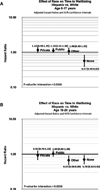Racial disparities in pediatric access to kidney transplantation: does socioeconomic status play a role?
- PMID: 22226039
- PMCID: PMC3951009
- DOI: 10.1111/j.1600-6143.2011.03888.x
Racial disparities in pediatric access to kidney transplantation: does socioeconomic status play a role?
Abstract
Racial disparities persist in access to renal transplantation in the United States, but the degree to which patient and neighborhood socioeconomic status (SES) impacts racial disparities in deceased donor renal transplantation access has not been examined in the pediatric and adolescent end-stage renal disease (ESRD) population. We examined the interplay of race and SES in a population-based cohort of all incident pediatric ESRD patients <21 years from the United States Renal Data System from 2000 to 2008, followed through September 2009. Of 8452 patients included, 30.8% were black, 27.6% white-Hispanic, 44.3% female and 28.0% lived in poor neighborhoods. A total of 63.4% of the study population was placed on the waiting list and 32.5% received a deceased donor transplant. Racial disparities persisted in transplant even after adjustment for SES, where minorities were less likely to receive a transplant compared to whites, and this disparity was more pronounced among patients 18-20 years. Disparities in access to the waiting list were mitigated in Hispanic patients with private health insurance. Our study suggests that racial disparities in transplant access worsen as pediatric patients transition into young adulthood, and that SES does not explain all of the racial differences in access to kidney transplantation.
© 2012 The American Society of Transplantation and the American Society of Transplant Surgeons.
Conflict of interest statement
The authors of this manuscript have no conflicts of interest to disclose as described by the
Figures


Comment in
-
Transplantation: role of race and socioeconomic status in transplant access.Nat Rev Nephrol. 2012 Jan 31;8(3):130. doi: 10.1038/nrneph.2012.6. Nat Rev Nephrol. 2012. PMID: 22290544 No abstract available.
References
-
- Young CJ, Gaston RS. Renal transplantation in black Americans. N Engl J Med. 2000;343:1545–1552. - PubMed
-
- USRDS. Bethesda, MD: National Institutes of Health, National Institute of Diabetes and Digestive and Kidney Diseases; 2010. US Renal Data System. Annual data report: Atlas of chronic kidney disease and end-stage renal disease in the United States.
-
- Byrne C, Nedelman J, Luke RG. Race, socioeconomic status, and the development of end stage renal disease. Am J Kidney Dis. 1994;23:16–22. - PubMed
-
- Brancati FL, Whittle JC, Whelton PK, et al. The excess incidence of diabetic end-stage renal disease among blacks: A population-based study of potential explanatory factors. JAMA. 1992;268:379–384. - PubMed
Publication types
MeSH terms
Grants and funding
LinkOut - more resources
Full Text Sources
Medical

